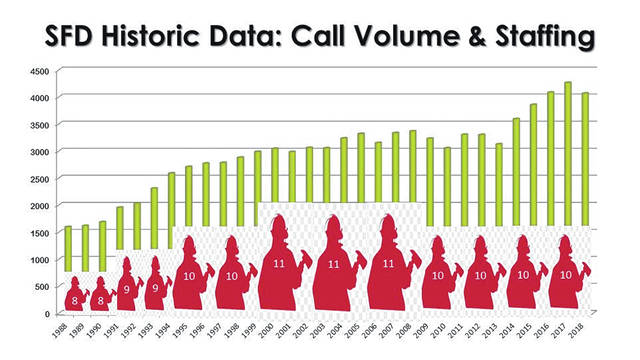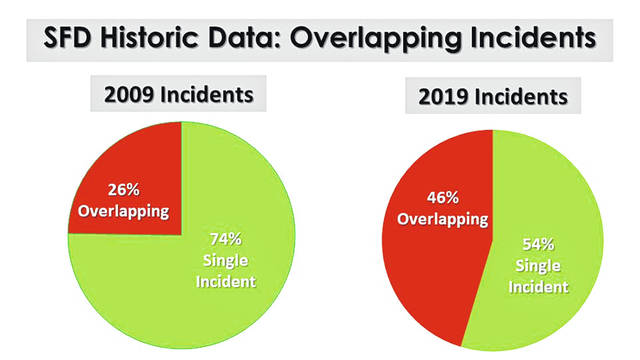

Editor’s note: There are two 0.15 percent municipal income tax levies that will be presented to Sidney voters on the Nov. 5 ballot. This article focuses on the fire levy. The street levy will be addressed in Wednesday’s paper.
SIDNEY — Sidney registered voters are being asked to approve the 0.15 percent fire operations income tax levy on the Tuesday, Nov. 5, ballot. The levy will provide permanent funding for fire department operations.
The original 0.30 percent income tax levy, which intended to help address fire operation needs, was first presented on the ballot in May when it was combined with street maintenance needs. The levy was to replace the current 0.25 percent municipal street levy that will expire Dec. 31, 2019. It was voted down in May.
This Election Day, a levy to provide funds for fire operations, is being presented alone after being separated from the streets’ needs.
“After the combined levy failed in May,” Sidney Mayor Mike Barhorst said, “City Council again debated whether to put both issues on the ballot independent of each other or place a single issue on the ballot. The feedback council members received was the issues should be split, allowing each issue to stand or fail on its own. As a result there will be two issues on the November ballot.”
Sidney citizens identified police and fire safety, and infrastructure, as top priorities, when polled earlier this year, Barhorst said in May when asked why voters should vote “Yes.”
Sidney Fire Chief Brad Jones emphasized, “The staffing is the key. The levy will allow us to handle our historically high call volume. The staff will enable us to provide excellent customer service to the entire community.”
“This is an operations levy designed to first address SFD staffing shortages, the bricks and mortar of a station are secondary. Please note in 2014, Piqua passed a 0.25 percent safety service tax increase to address their staffing issues. SFD is operating with the same staffing level as we had in 1994 but in the same time span we’ve had a 60 percent increase in emergency call volume. If someone is going to compare us to Piqua compare us to their successful 2014 levy,” Jones said.
If passed by voters, levy funds will go toward staffing and the construction of a third fire station north of Sidney at 2401 Wapakoneta Ave. on the 12.5 acres of land the city of Sidney purchased in 2017. The fire station is envisioned to have a 50-plus year life span.
A construction cost of $4.3 million for Station No. 3 was estimated after a master planning process was completed earlier this year. As outlined in the 2019-2023 Five-Year Plan, City Manager Mark Cundiff said during a February Sidney City Council meeting, the city budgeted $50,000 in 2018 for conceptual design and $275,000 in 2019 for initial engineering services for the proposed third fire station. If the proposed levy does not pass, the $275,000 will not be spent.
The levy will cost taxpayers $1.50 per $1,000 of income. For a person earning $35,000, that’s around $4.38 per month or $52.50 a year.
The levy applies only to municipal taxable income for people who work or live in the city of Sidney. It does not tax Social Security, pension or disability benefits, tax investment income or income from 401K plans.
“A small part will go to the building. Less than 18 percent (of levy funds) will go to the building. Most of the expense will go to cover the staffing. I hope the community will support the levy,” Fire levy committee member/Wilson Health CEO Tom Boecker said. “This is really a staffing issue. The volume of staffing does not match up to the volume of calls.”
Barhorst pointed out that in nearly four decades, “the city has grown from 5,204 acres to 7,740.89 acres, a 48 percent increase in size. In addition, Sidney’s population has grown 20.2 percent. That population does not include the several thousand people who do not live here but come to Sidney to work each day and use city services.
“Perhaps more importantly, the call volume at the SFD has increased 899.55 percent over that same period of time. Call volume is at an all-time high. Over the past three years, call volume has surpassed 4,000 calls per year, or an average of more than 11 per day,” he continued. “We still have the same staffing levels that we had in 1995, when call volume was about six calls per day.”
During a recent presentation on the fire levy, Jones called attention to the difference in the call volume from 1994 to 2018.
“There is a 60 percent increase in call volume in that time span. Three-quarters of the time, in 2009, we only had one call going on. In 2019, due to the increase of call volume, we are up to 46 percent of the time with multiple alarms going on at the exact same time. Almost half of the time our crews are tied up on multiple incidents. Ten years ago, 75 percent of the time we still had a crew available at the station to handle the call. In 2019, we don’t,” Jones said. “This is an operating levy. This is to address our staffing deficiencies.”
Ed Thomas, fire levy committee member/Sidney-Shelby County YMCA director said, “It is a misunderstanding that the levy is not just for a facility, but that staffing is needed. We have great coverage in some areas, but not all of town.”
Ten years ago, Jones said, Fire Chief Stan Crosley conducted a Community Risk Assessment (CRA) that identified the need for additional staffing and to address the Sidney Fire Department’s (SFD) response times. Then in 2014, Jones said he updated the CRA and it again showed a need for more staffing and to address response times.
“The Sidney Fire Department has been telling us for more than 40 years that they need additional help to meet the growing demands of the community,” Barhorst said. “Let’s not wait until there is some tragedy in the community before we decide to provide them the tools they need to save lives.”
A PowerPoint presentation on the fire levy can be found by clicking the “Levy Presentation” link on the city of Sidney’s Fire and Emergency Services web page at http://www.sidneyoh.com/fire/index.asp A link to “Frequently Ask Questions” is also available on the web page.



